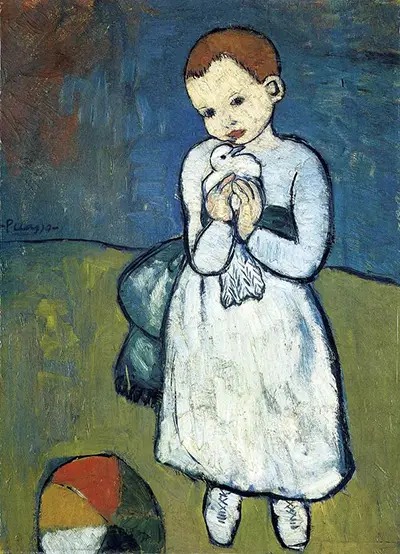Picasso's Blue period dates roughly from 1901- 1904, named for the blue hues that dominated his output at this time.
A key piece from this period was Old Guitarist which defines clearly the features of Picasso's art at the time.
The works were generally sombre in tone and suggested the emotional turmoil that Picasso was dealing with as he came to terms with the suicide of his friend Carlos Casagemas.
Typically he depicted the disenfranchised as his subject matter, choosing to use their plight and their suffering as an output for his own.
Child With a Dove marginally predates the Blue Period and its content reflects this. Whilst the characteristic blue palette is obvious in the walls behind the child, it is softened by the brighter colours in the rest of the piece.
The work is tender, in contrast to other pieces from the Blue Period, and suggests a deep affection for the subject matter.
Conchita Picasso y Ruiz and Child With a Dove
There is much disagreement about Child with a Dove and what it represents- even whether Picasso painted a boy or a girl is questioned.
There are many ways to read it, but it was painted at a period when Picasso was living through significant change- moving between Paris and Barcelona - and also immense hardship financially and emotionally.
Aside from the death of Casagemas Picasso was still dealing with the death of his youngest sister Conception (Conchita). She died of diphtheria in 1895 and her death was a horrific blow to the 14 year old Picasso.
The significance of this tragedy upon his life is clear throughout his work, where she is a recurring theme. She appears in La Minotauromachie as a child with a lamp and then as an adult with a lamp in Guernica.
As such it is possible to understand the child in this work as a representation of Conchita. There is a connectedness between her and the dove: both are dressed in a simple white that suggests their innocence. In this sense the dove becomes a metaphor for the young life that Picasso could not let go of.
This reading of the painting explains the tenderness with which 'Child With a Dove' is painted - the child looks trustingly out of the work, at peace with their world. It is the immortalisation in oils of something that cannot be held onto in life.
Stylistic Development
Picasso never stopped learning, developing and moving forwards with his style. He was a key player in cubism and in modernism, but neither of these styles define him or easily typify his output. As such works need to be looked at individually to assess their influences and their impact.
At the time that he painted this work Picasso was only 20 years old; yet it was only 6 years later that he produced Les Demoiselles d'Avignon. This gives a fascinating timeline of change in Picasso's style as he found his feet as an artist and gained confidence in expressing his individuality.
As one of Picasso's earlier pieces 'Child With a Dove' lays testament to the post-impressionists. Picasso has made it his own through the changed sunset palette of Cezanne or Gauguin that has become something starker and more blue whilst retaining their style- their influence over the young Picasso is clear.

